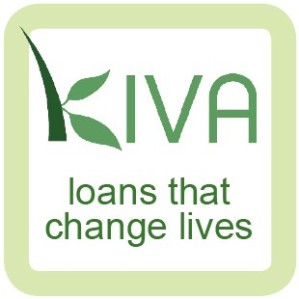 I first learned about Kiva, the microfinancing organization shortly after their site was launched in 2004. The premise behind microfinancing is that donors can loan as little as $25 directly to an individual entrepreneur in the developing world. A seamstress in Tanzania, for instance, can apply for a loan of up to $1,200—not much by “first world” standards, but enough to launch a successful business in Tanzania. The recipient then repays the loan when they have met their financial goals and contributors are given the chance to reinvest their money with another Kiva recipient.
I first learned about Kiva, the microfinancing organization shortly after their site was launched in 2004. The premise behind microfinancing is that donors can loan as little as $25 directly to an individual entrepreneur in the developing world. A seamstress in Tanzania, for instance, can apply for a loan of up to $1,200—not much by “first world” standards, but enough to launch a successful business in Tanzania. The recipient then repays the loan when they have met their financial goals and contributors are given the chance to reinvest their money with another Kiva recipient.
Microfinancing has been touted as an innovative alternative to large-scale government aid that often never reaches the people most in need. Kiva has been wildly successful, generating nearly $65 million in loans in four years (not to mention a mountain of media coverage). Notably, Kiva reports that the current economic slump has not slowed the pace of contributions to their program; a sign that the microfinancing formula might be sustainable even in the bleakest times.
Now, Kiva has announced plans to loan up to $10,000 apiece to entrepreneurs in the U.S., a risky move that will test the core of the microfinancing concept. Will the model work at this larger scale? Will donors be enticed by businesses in their own backyard the way they have been with those halfway around the world?
I find myself wondering if microfinancing provides a model than can help designers build entrepreneurial businesses. So many great ideas die on the shelf simply because there is no access to the seed money necessary to move them forward. Often times the seed money that is needed is relatively modest and traditional forms of venture funding: bank loans, venture capital, and angel investors can be overkill.
Business Plan competitions like the Minnesota Cup, here in my home state, can offer an option for seed funding, but they’re not a sure thing and the rigid timing doesn’t always favor a time-sensitive concept. Although, I should point out that our participation in the 2005 Minnesota Cup was a pivotal point for Lisa and me in the development of HealthSimple.
I hope to see some design-driven ventures test this new domestic version of Kiva. And perhaps the success of microfinancing will inspire other organizations to develop a model of funding for start-up ventures that is more community-based, participatory, accessible—and design focused.

1 comment
Comments feed for this article
June 22, 2009 at 11:43 pm
Video Script
This is a great moved by kiva. I donate my upgrade fees to kiva and recently I loaned couple of loans to US entrepreneurs. I’m sure this will work out.